Moka pots are among the most popular brewers out there. But they’re still misused from time to time. To help you avoid mishaps with your coffee maker, we’ve come up with a list of 16 Moka pot mistakes you need to avoid while brewing your coffee.
1) Putting Your Moka Pot In The Dishwasher Can Ruin It
You should never put an aluminum Moka Pot in the dishwasher. The hot water and strong detergents can cause a chemical reaction that will oxidize, corrode, and darken the pot.
In some cases, a soot-like substance may even form on the surface of the Moka Pot as a result of these reactions.
If your Moka Pot does end up in the dishwasher somehow, try cleaning it with a solution of 2 parts water and 1 part vinegar. Alternatively, there’s a product called Barkeepers Friend (link to Amazon) that’s highly rated for making coffee makers look like new.
(Personally, I haven’t tried Barkeepers Friend, but it has a lot of great reviews and is said to work well. You can get Barkeepers Friend on Amazon.)
Related Post:
- Moka Pot Oxidation ( Why Are black Spots on My Moka Pot?)
- Aluminum vs Stainless Steel Moka Pot ( Which One to Pick?)

2) Scrubbing Your Moka Pot With Abrasive Materials Can Cause Damage
Don’t scrub your Moka Pot with abrasive items like steel wool or steel sponges. These products can scratch the protective layer from the surface of your brewer and lead to damage or discoloration.
Keep in mind that aluminum is a relatively soft metal. This is why it’s the popular choice for making Moka Pots; because it’s easy to mold. But this softness also makes it easy to scratch.
Also, aluminum Moka Pots typically have a protective layer that protects them from oxidation. When you scratch the brewer with abrasive products, this protective layer is removed which can lead to discoloration.
3) Don’t Underfill Your Moka Pot With Water
Depending on the size of your Moka Pot, there may be times when you don’t want a full pot of coffee; instead, you may want half. But you shouldn’t underfill your Moka Pot’s boiler.
Moka Pots use vapor pressure to force water up through the brewer. And if there’s too little water in the boiler, the Moka Pot may not generate enough pressure to properly brew your coffee.
If you want to brew a smaller amount of coffee, your best bet is to get a smaller Moka Pot such as the 1-cup or 3-cup version. (Links go to Amazon.)
(To read more about Moka Pot sizes, check out our “Moka Pot Size Guide“.)
Related Post:
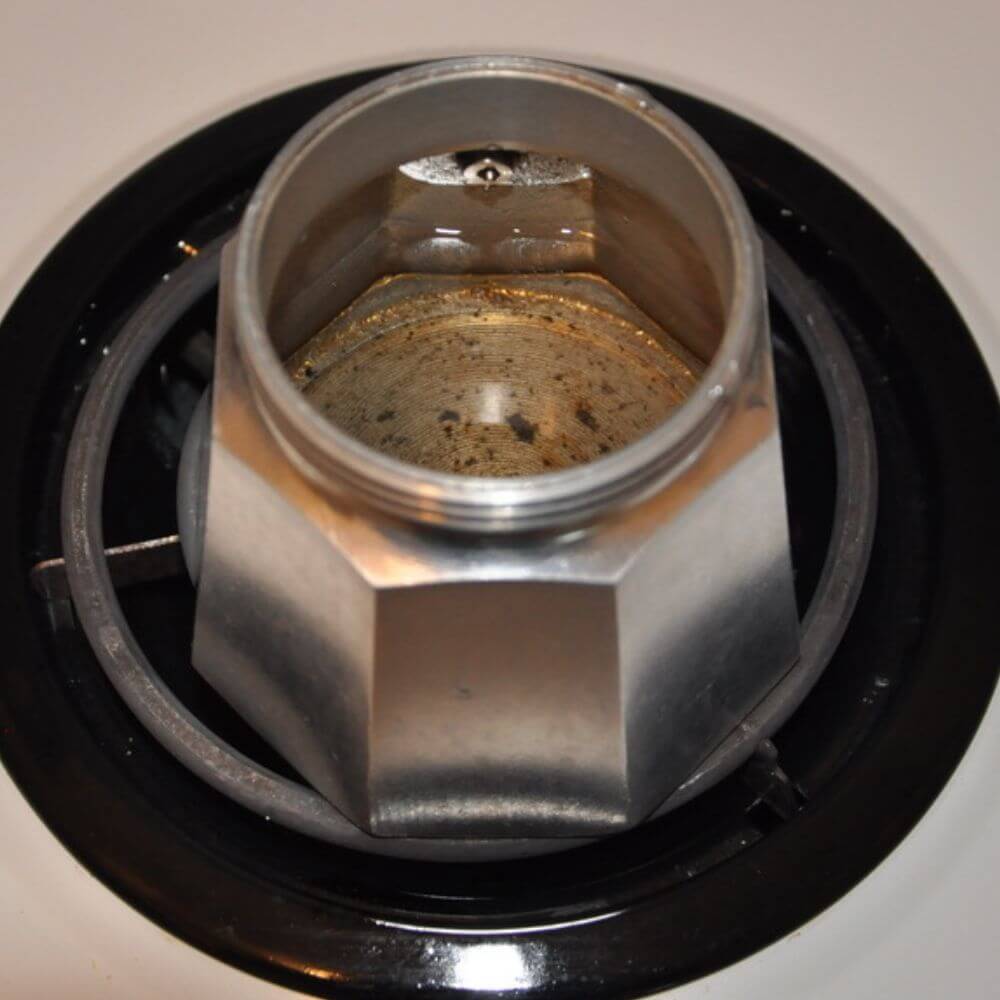
4) Don’t Overfill Your Moka Pot With Water
Overfilling your Moka Pot can also create problems.
Because Moka Pots use pressure to brew coffee, there’s a risk of too much pressure building. This excess pressure could damage your Moka Pot or even cause it to explode.
This is why the boiler has a safety valve that allows steam to escape when too much pressure builds. However, if you overfill the Moka Pot and cover the safety valve, it won’t be able to relieve pressure.
So, make sure you always keep the water level below the safety valve.
(To read more about exploding Moka Pots, check out our post “Can A Moka Pot Explode?“)
5) Banging The Funnel Basket Against Hard Objects Can Damage The Brewer
It’s common for people to bang the funnel basket against a trash can or kitchen sink to dispose of used coffee grinds. However, you should never bang the funnel basket against hard objects like this.
The funnel basket should fit snuggly into the Moka Pot’s bottom chamber. But by banging the funnel against things, you can damage or dent it.
If it’s damaged, the funnel won’t fit snuggly within the boiler and the Moka Pot could end up sputtering. In that case, you may need to get a new funnel basket. (Link goes to Amazon. But make sure you get the right funnel size for your Moka Pot.)
(To read more about why your Moka Pot may be sputtering, check out “Why does my Moka Pot Sputter“.)
6) You Shouldn’t Brew Moka Pot Coffee On High Heat
Moka Pots are built to be placed on direct heat. However, you shouldn’t place them on high heat as this can burn your coffee grounds before the coffee brews.
It takes several minutes for sufficient vapor pressure to build to brew the coffee. During this time, the coffee beans will be directly over high heat which can burn them and create burnt or bitter-tasting coffee.
Instead, place your Moka Pot over medium heat. This will allow water to heat without overheating the coffee grounds.
Related Posts:
- Ideal Moka Pot Temperature: How Hot Should My Stove Be?
- Do Moka Pots Works On Induction Stoves ( Why Or Why Not?)
- What’s The Best Induction Moka Pot? ( Top 5 Picks)

7) Don’t Use Cold Water In Your Moka Pot
You should not use cold water to brew Moka Pot coffee. There are two primary reasons for this.
First, it takes longer to brew coffee with cold water than with hot water. This extra time could cause your coffee beans to cook while the water is heating up.
Second, when you use cold water, the coffee starts to brew before the water reaches the ideal temperature. So, to get a better brew, heat your water first before pouring it into the Moka Pot.
(To learn more about this, check out our post “Should You Use Hot Or Cold Water In A Moka Pot“)
8) Don’t Overfill Or Tamp The Coffee Grinds In Your Moka Pot
Although Moka Pots are called stovetop espresso machines, you should not tamp or overfill your Moka Pot.
When brewing true espresso in an Espresso machine, the grinds are tamped, or pressed, into the portafilter basket. This tamping makes it harder for water to flow through the beans, which forces more coffee to be extracted.
Since Moka Pot baskets are somewhat similar to portafilter baskets, it can be tempting to overfill the grinds in your Moka Pot and tamp them down.
But keep in mind that Moka Pots don’t generate nearly as much pressure as espresso machines.
So, the resistance created by tamping will most likely prevent water from flowing. This can cause excess pressure to build and may even result in your Moka Pot exploding.
(To learn more about this, check out our post “Should You Tamp A Moka Pot?“)
Related Posts:
- Moka Pot Strenght ( How Strong Will My Brew Be?)
- How To Reduce Sediment In A Moka Pot Coffee( 9 Easy Fixes!)
- Can You Use A Paper Filter In A Moka Pot? Pros And Cons!
9) Don’t Leave Your Moka Pot On The Heat Once It Starts Gurgling
Moka Pots use vapor pressure to force water up through coffee grounds. Once most of the water is brewed, steam will start to force its way through the coffee grounds.
This steam is what makes the gurgling noise, but it also overheats the coffee grounds.
If you allow too much steam to heat the grounds, it will cause your coffee to taste burnt and bitter.
So, make sure to remove your Moka Pot from the heat as soon as it starts to gurgle. If you want to know more about this matter, read our article “When to take Moka Pot Off The Heat ( Get The Perfect Brew!)“
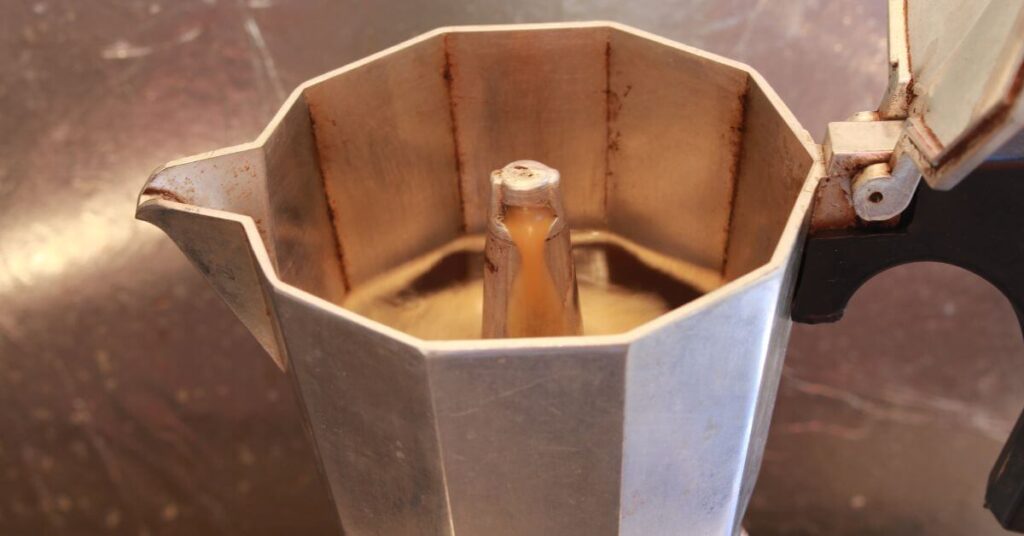
10) Tightening Your Moka Pot Before Storing Could Wear Out The Gasket
Bialetti recommends storing your Moka Pot disassembled (link to Bialetti). But, many people (including us) store it assembled to make it less likely that one or more pieces will go missing.
However, you should not screw the top and bottom chambers together tightly before putting the brewer away. Doing so puts pressure on the rubber gasket and can cause it to wear out more quickly than it would otherwise.
Instead, attach the top and bottom chambers loosely before storing.
And be sure to occasionally check your gasket and filter plate to make sure they’re not cracked or damaged. If they are, you’ll most likely have to replace them. However, the gasket and filter are fairly cheap on Amazon.
11) Don’t Use The Wrong Grind Size In Your Moka Pot
Using the wrong grind size in your Moka Pot can result in low-quality coffee or even create issues with your brewer.
Generally, medium-fine grinds should be used when brewing Moka Pot coffee. If your beans are ground finer than this, it’ll result in over-extracted coffee and could potentially clog your Moka Pot.
It could also result in sludgy coffee since smaller coffee grinds can easily slip through the filter.
On the other hand, if you use coarser grinds in a Moka Pot, it could result in under-extracted coffee.
(To learn more about this, check out our post “The Best Grind Size For A Moka Pot“.)
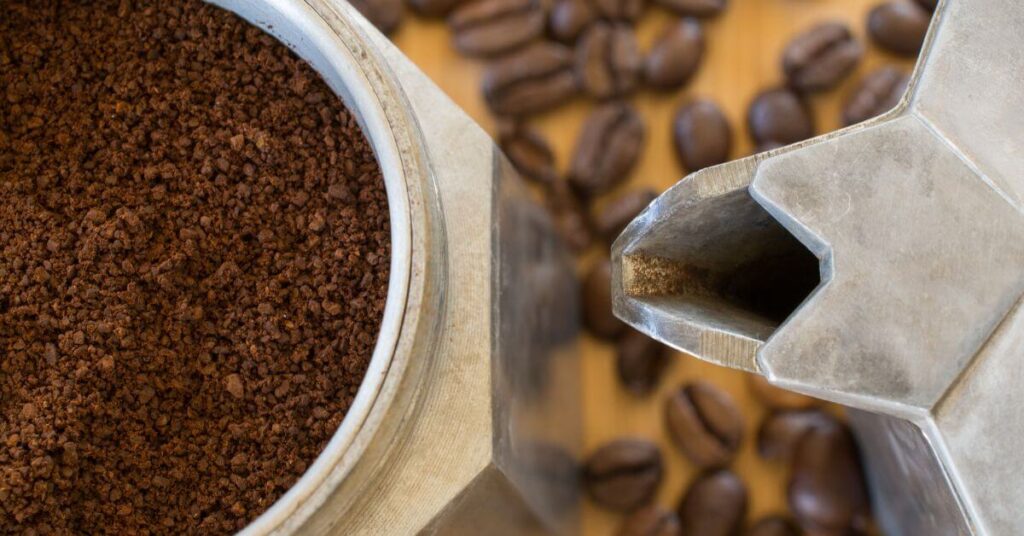
12) Don’t Store Your Moka Pot Wet Or It May Oxidize
You should always dry your Moka Pot thoroughly before storing it. Leaving any part of it wet could result in oxidation.
If it does oxidize, you’ll see white deposits, black deposits, or other types of discoloration on your Moka Pot. However, this won’t really affect the flavor of your coffee.
To prevent oxidation, make sure you dry each piece of your Moka Pot separately or let it air dry.
(To learn more about oxidation and how it can affect your Moka Pot, check out our post on Moka Pot Oxidation)
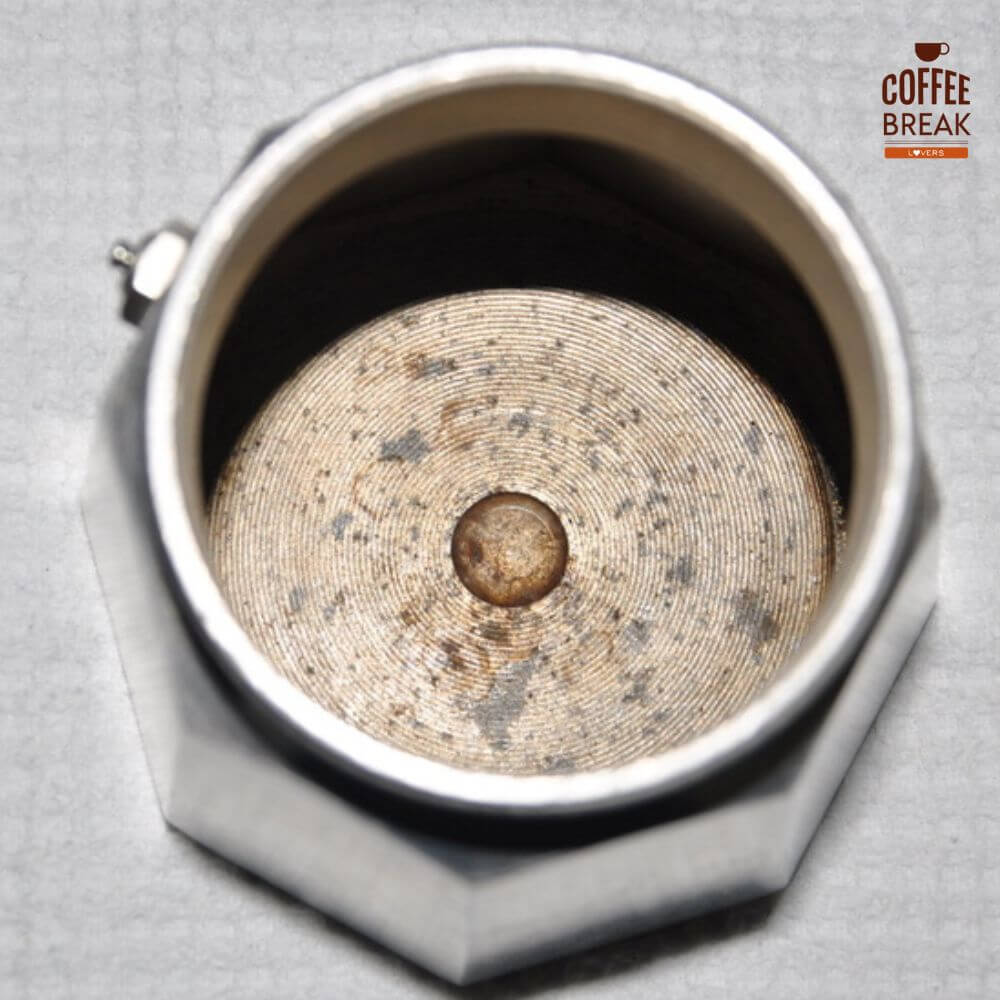
Related Post:
13) Don’t Use Your Moka Pot Unless It’s Assembled Tightly
Make sure your Moka Pot is well assembled before you try to brew with it. The top chamber should be screwed tightly onto the bottom chamber.
If you don’t tightly assemble your Moka Pot, it may not be able to build enough pressure to brew your coffee properly. Instead, water and steam will leak from the area where the top and bottom chambers connect.
If this happens you should immediately remove the Moka Pot from the heat. And be careful not to try and tighten the Moka Pot with your bare hands, as it’s still very hot!
14) Don’t Use Extracts or Infusions in Your Moka Pot
You should not try to use extracts, teas, or instant coffees in your Moka Pot. These items may clog the filter and make it difficult for water to flow through the Moka Pot.
Even though Bialetti advises against it, many people do successfully brew teas in their Moka Pot.
However, keep in mind that tea leaves have a different size, shape, and surface area than ground coffee. They also move differently when water is flowing through them. Because of this, there’s always the possibility that the filter can be clogged by teas or extracts.
And if that happens, there’s a chance that the Moka Pot can explode.
15) Don’t Place Your Moka Pot On A Heat Source Without Water
You should never place your Moka Pot on a hot stove unless there’s water in the boiler.
This has happened to a few people who simply forgot to put water in their Moka Pot. However, due to aluminum’s high heat tolerance, the metal portion of the Moka Pot is generally fine. But the rubber gasket and coffee grinds can easily burn.
If this happens you may find that your gasket is stuck to the aluminum or is at least warped. Luckily, rubber gaskets are available on Amazon and can be cheaply replaced.
Related Post:
16) Don’t Brew Milk In Your Moka Pot
Moka Pot coffee is meant to be made with water and should never be brewed with milk.
Keep in mind that Moka Pots use vapor pressure to brew your coffee. The pressure forces the water up into the funnel and through the coffee grinds. The brewed coffee is filtered, goes up the central column, and into the top chamber.
Now imagine what would happen if this process was done with milk instead of water.
First of all, by the time enough pressure was built, the milk would have burnt in the boiler. Any milk that did move up the funnel would curdle and stick inside the funnel. The milk fats wouldn’t be able to flow through the coffee grinds and curdled milk would clog inside the filter and central column.
In short, it would be a very messy and harmful process.
(If you want to learn more about using milk in a Moka Pot, check out our post “Can You Use Milk In A Moka Pot?“)
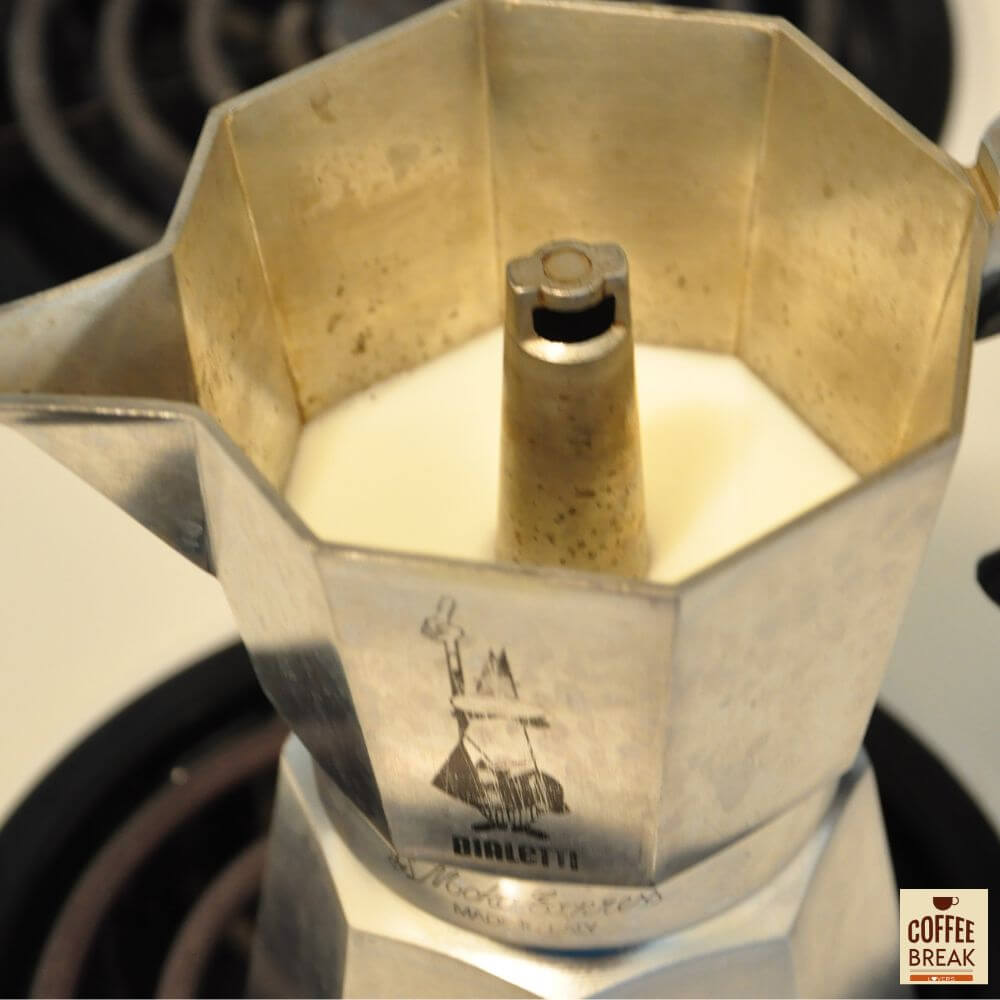
Key Takeaways – Moka Pot Mistakes To Avoid
Moka Pots are fairly simple and easy-to-use coffee makers. However, there are several mistakes people make with them.
Hopefully, this list will help you avoid some of the most common issues when handling a Moka Pot. If there are any that we didn’t list here, be sure to let us know in the comments below!
Cheers Coffee Lovers!

KEEP READING
- Bialetti Brikka vs Moka Express (Which Should I Choose!?)

- Best Bedroom Coffee Maker (Top 6 Picks!)

- Are Blade Grinders Really That Bad?

- 16 Moka Pot Mistakes To Steer Clear Of!

- What Are The Parts Of A Moka Pot? (Easy Assembly Guide!)
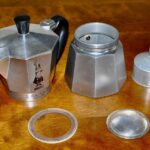
- Do Moka Pots Work On Induction Stoves? (Why Or Why Not?)

- What’s The Best Induction Moka Pot? (Top 5 Picks!)
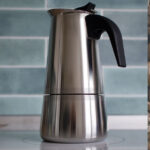
- Moka Pot Oxidation (Why Are Black Spots In My Moka Pot?)

- Moka Pot Size Guide (What Size Moka Pot Do I Need?)


Idalmis is co-owner of Coffee Break Lovers. She is a Cuban coffee enthusiast that is passionate about coffee and coffee culture.



